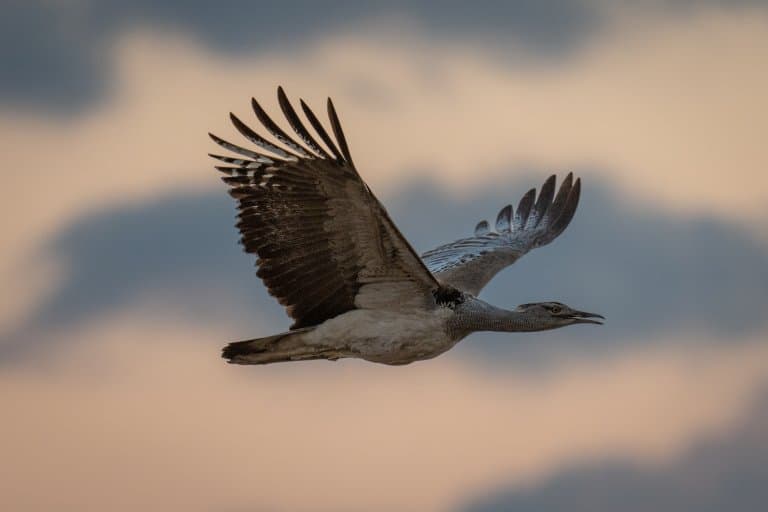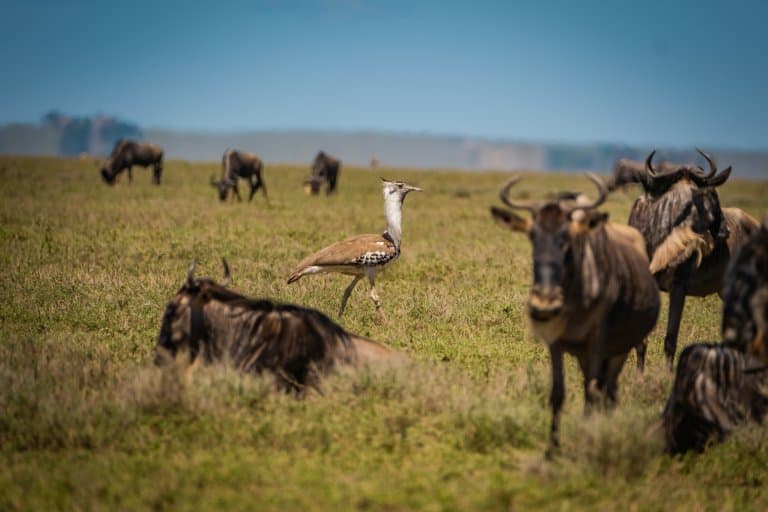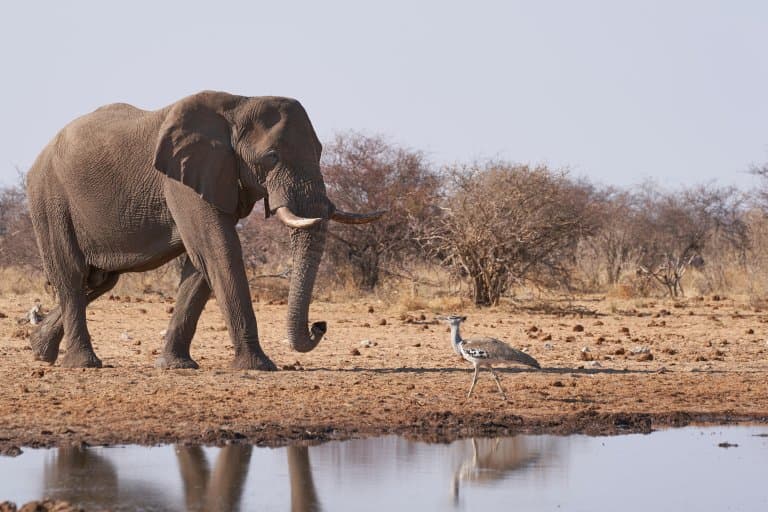Kori Bustard Profile
There’s a lot in the savannah that doesn’t get the recognition it deserves.
While the high-profile cases of brute force and ignorance are the most popular targets of safari tourism, the kori bustard is overlooked as a spectacular and powerful bird running around almost in secret, with record-breaking qualities and a very stylish mating performance.
The kori bustard is a ground-dwelling species from the bustard family, that is the largest flying bird native to southern Africa.

Kori Bustard Facts Overview
| Habitat: | Open grassy areas, scrubland and bush |
| Location: | Southern and Eastern Africa |
| Lifespan: | 28 in captivity |
| Size: | 105 – 135 cm (3.5 – 4.5 ft) in height, 230 – 275 cm (7.7 – 9 ft) wingspan |
| Weight: | Up to 18 kg (40 lb), possibly more |
| Color: | Grey and brown patterned |
| Diet: | Insects, lizards, snakes, seeds, gum from acacia trees |
| Predators: | Lions, leopards, caracals, jackals, hyenas, eagles |
| Top Speed: | Slow |
| No. of Species: | 1 |
| Conservation Status: | Neat Threatened |
Kori bustards are the biggest of the 26 species of bustards that range from 40 cm up to 135 cm in height. These are prehistoric-looking birds with powerful legs that can kick and stomp.
They inhabit open grassy areas and are opportunistic omnivores that forage for food with their bills, snapping up insects such as locusts, grasshoppers, caterpillas, beetles and termites. They occasionally eat carrion, and small lizards or snakes, as well as grasses, plants, seeds and Acacia gum to compliment their diet.
Kori bustards can often be found in small groups of half a dozen birds, but can occassionally congregate into larger groups of up to 40 individuals. Despite being relatively quiet by bustard standards, they have a wide range of calls and are capable of expressing themselves.
They can also fly, though you might not know it from looking at them. Living on the ground in the African plains means they have a lot of predators, so they have to be tough.
Despite this, they don’t squabble often and put themselves forward as lovers, not fighters.
Interesting Kori Bustard Facts
1. They can fly if they want to
They can leave their friends behind. But doing so takes a lot out of them.
These birds stand at around a meter tall and have one of the biggest wingspans on record at 7.7 – 9 ft. They’re large animals and with a hefty mass to boot.
Kori bustards have been said to reach 20kg, and have been reliably weighed at 18kg, which makes them one of, if not the heaviest flying bird left.
Because of this impressive bulk, they try not to fly too much. 1

2. Fat bustards
While they can fly, these big bustards amble around most of the time at a leisurely pace of around 1 kmph. Walking is how they get around in most cases, but they can also run when they have to.
Running speeds are hard to verify, but they do seem to be at least as fast as a fleeing human, probably a bit faster. And since these are weighty dinosaurs with incredible kicks, it’s best not to upset them.
However, most cases of running are defensive, and when the time comes to take off, they will do as the paragliders do, and run into the wind. Flight is also primarily used to get away from something and is an expensive use of resources.
3. They’re master strutters
Birds win in almost every category when it comes to mating displays, so it should be no surprise that these big bustards put on a good performance and engage in lek mating.
When it’s time to go a-courtin’, the male kori bustard’s testosterone increases significantly.
Like Froggie, he puffs up his neck, creating an air-filled chamber that puts the legendary amphibian’s to shame.
This balloon display is accompanied by a fantastic erection (as any good strut should be) of both the crest on the bird’s head and its tail.
This display can be maintained for up to an hour, and the grey neck feathers puff out to four times their width, displaying the white colouration at their base and framing the bird’s handsome little face as he walks around proudly.
He struts around showing off this billowing frill and booming out a deep and guttural sound from within it. This sound is hard to hear on recordings because it’s such a low frequency, but it’s loud enough to carry for up to 1km. 2

4. Male kori bustards take no part in parenting
Males, who often weigh 2-3 times as much as their female counterparty will try to breed with as many female kori bustards as possible – and play absolutely no role in raising their young after breeding.
Nests are shallow hollows in the earth, and are generally hidden near trees or behind other areas of the landscape.
5. They also bark and growl
Little baby bustards are small enough to be vulnerable to predation, and will often be taken by predators. Sadly, up to 82% of kori bustard chicks die in their first year of life.
For the ones who survive, they can thank their bustard mothers, who will intimidate enemies with barks and growls.
Bustards have a wide range of other calls, too, including grunting, roaring, grunting and sneezing, which they employ strategically, depending on the context.
6. They can fight
Kori bustards have been seen fighting with secretary birds, presumably for the title of most dinosaur. While not as agile as the lighter secretary bird, their weight makes them a pretty even match, and they’re often seen squabbling amongst themselves, too.
When male bustards fight it’s usually a simple test of strength, and the weaker one will fly away when it becomes apparent they can’t win. Fights do sometimes result in injuries, but it’s more common that only the loser’s ego will be harmed.
7. Their Afrikanns common name is ‘Gompou’
This translates to ‘gum peacock’, in reference to their taste for Acacia gum.
Acacia are a genus of trees from the pea family, and the hardened sap of various species of this tree are known as Acacia gum. It’s actually used as an emulsifier in food amongst other things.
8. Blue wildebeest are their friends
The kori bustard will often follow blue wildebeest herds and snack on small animals and insects that are disturbed by them!

9. Many are killed by powerlines
Collisions with powerlines in South Africa are so common that they’re contributing to population declines in bustards in these areas.
They’re the second-most affected after Ludwig’s Bustard, according to mortality surveys, with an estimated loss of up to 1,260 a year in just one region assessed.
Power lines are a big problem for birds all over the world, and there isn’t enough focus going into designing them with wildlife in mind. This is particularly true in the developing world where budgets are small and electrification is urgent.
With bustards, there’s a blind spot immediately in front of them which causes them to fly into power lines.
Because of this, Conservation Namibia has published recommendations for towers to be staggered.
Simply by avoiding opposite-facing parallel arrangements of power lines towers, there should be enough of a visual cue from the towers on either side of the bird for them to avoid collisions with the wires by two-thirds. 3
10. They’re also threatened directly by humans
In other countries, they’re killed deliberately. They’re hunted for bush meat and illegally kept as pets.
In Botswana, this unregulated hunting is a significant threat, and there are suggestions that the bird is sometimes used in traditional medicine too.
These threats have led to the shrinking of the bird’s range by 20% in East Africa and 10% in Southern Africa in the last 50 years. 4

Kori Bustard Fact-File Summary
Scientific Classification
| Kingdom: | Animalia |
| Phylum: | Chordata |
| Class: | Aves |
| Order: | Otidiformes |
| Family: | Otididae |
| Genus: | Ardeotis |
| Species Name: | Ardeotis Kori |
Fact Sources & References
- Elinor M. Lichtenberg, Sara Hallager (2006), “A description of commonly observed behaviors for the kori bustard (Ardeotis kori)“, Japan Ethological Society and Springer.
- Hallager, S., & Lichtenberg, E. M. (2007), “NEW DISPLAY BEHAVIOR IN MALE KORI BUSTARD (ARDEOTIS KORI STRUTHIUNCULUS)“, The Wilson Journal of Ornithology.
- Pallett, J., Simmons, R., & Brown, C. (2022), “Staggered towers on parallel transmission lines: a new mitigation measure to reduce collisions of birds, especially bustards“, Namibian Journal of Environment.
- “Kori bustard“, Smithsonian’s National Zoo & Conservation Biology Institute.
